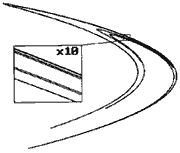
Lessons from the Edge
“The Science of Complexity”
In
which Julien Sprott reviewed basic concepts of complexity science, and
the similar patterns that can be observed across diverse systems.
Julien Clinton Sprott, PhD, Professor of
Physics, University of Wisconsin
Complexity science deals with Dynamical Systems:
- Some characteristics
of Dynamical Systems are:
- The system evolves over time according to a set of rules.
- The present conditions determine the future.
- The rules are usually nonlinear – they are random.
- There may
be many interacting variables.
- Biological sciences are only just beginning to understand this, and social sciences are further behind – they “still believe in free will.”
Examples of Dynamical Systems:
- Dynamical systems
are everywhere. They include:
- The Solar System
- The atmosphere/ weather
- The economy/ stock market
- The human body (itself composed of many dynamical systems)
- The spread of epidemics
- The internet
There are four forms of Dynamical Systems:
|
Linear/ simple rules
|
Non-linear/ complex rules
|
|
|
Few variables
|
Regular
|
Chaotic
|
|
Many variables
|
Complex
|
Random
|
Key points from the chart:
- Complex systems
can evolve with simple rules.
- Most real-world systems fall in the bottom-right quadrant; they seem to develop in a random way, where we can’t predict.
All systems display variability.
- This is a key
issue. Measure any system, and you’ll see variation within a range—
even in systems that appear to be regular and stable, such as a heart-beat.
- Even simple dynamic systems produce chaotic patterns.
- Chaotic
systems never repeat their behavior. This
makes long-term prediction impossible.
- Chaotic systems
depend sensitively on initial conditions. This is illustrated by
the “Butterfly effect,” which suggests that a butterfly flapping its
wings in Manila can cause a thunder storm in Houston, Texas.
- Chaotic systems
allow for short-term predictions, but not long-term prediction.
For example, we may know that it will be raining tomorrow afternoon,
but it is impossible to predict whether it will rain this time next
month.
- Chaos comes
and goes with a small change in some “control knob.” Even a slight
change in some variable can result in extreme shifts in system behavior.
- Chaotic systems tend to be fractal. That is, similar structures can be seen at different levels of “magnification.”
A look at attractors
- Attractors
are points to which movement is pulled. They create “basins” to which
behavior is drawn. Imagine a marble coming to rest at the bottom of
a bowl – that place is the attractor.
- Although attractors
create unpredictable movement, they also exclude many possibilities.

- A pattern created
by the “Henon Attractor” is shown to the left. Even though the line
seems to cross back over itself, in reality no two points are the same.
There is both order and randomness created by the attractor.
- Attractors are fractal in structure; they can be viewed at infinite levels of detail, and still look the same. (This is shown in the magnified portion of the Henon Attractor visual.)
A look at fractals
- Fractal: A geometric
image that is self-similar with structure on all scales. The detail
persists at all levels.
- Examples of fractals
include:

- bolt of lightning
- The leaf of a fern
- Your body’s vascular system
- Clouds
- Planetary rings
- The coast line of California
Summary: Some dynamics of Complex Systems
- They display emergent
behavior. That is, patterns can arise from random beginnings.
- They display self-organization.
Chaos gives rise to order.
- They evolve.
- They adapt.
- They are comprised
of autonomous agents.
- They can learn.
- They exhibit
artificial intelligence.
- They can die / become extinct.
An important, key message:
- “Nature is complicated, but simple models may suffice.”
Copyright
© 1999, VHA Inc. Permission
to copy for educational purposes only.